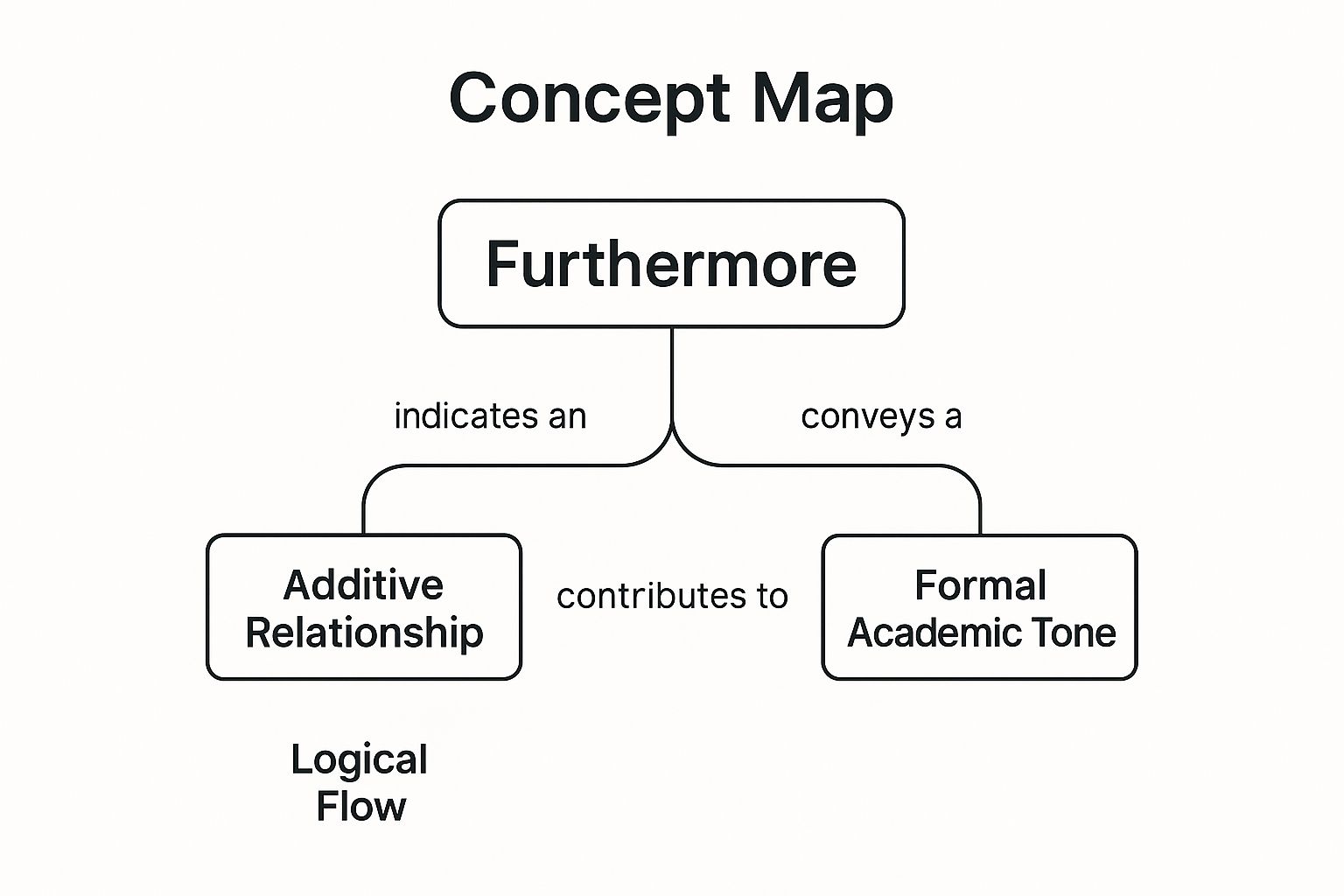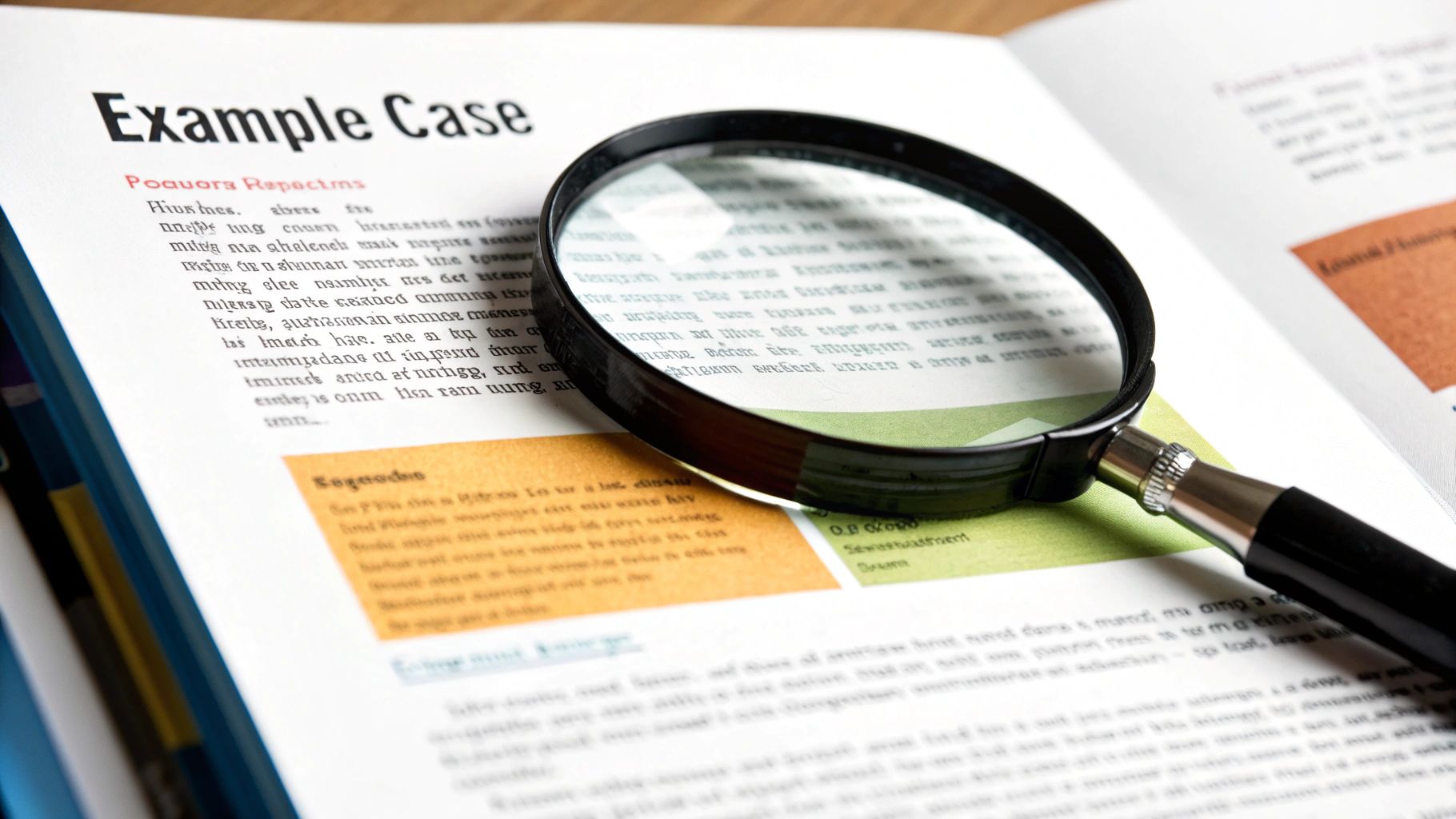
8 Essential Writing Sentence Starters for 2025
Published on 2025-10-02
Ever stared at a blank page, wondering how to begin? The right opening words can transform a good idea into a great piece of writing. The first few words of a sentence set the tone, establish logic, and guide your reader's attention. Mastering a diverse set of writing sentence starters is essential for creating clear, persuasive, and impactful content.
This guide isn't just a list; it's a strategic toolkit. We'll break down eight distinct categories of powerful sentence starters, moving beyond simple definitions to provide deep analysis and actionable tactics for each one. You will learn not just what to write, but why specific phrases work in different situations.
The goal is to equip you with the skills to elevate your writing from standard to standout. Whether you're drafting a critical business report, a compelling email, or a scroll-stopping social media update, these tools will help you communicate more effectively. For specific applications, such as crafting professional social media updates, you can explore strategies for writing LinkedIn posts that get noticed. Let's dive into the phrases that build better arguments and capture reader interest from the very first word.
1. Furthermore/Moreover Transitional Starters
When constructing a persuasive argument or a detailed explanation, your ideas need to connect logically. Sentence starters like "Furthermore," "Moreover," and "Additionally" are essential tools for building this connection. They signal to your reader that you are about to add another piece of information that supports or expands upon your previous point. Think of them as signposts that guide your audience through your train of thought.
These transitional phrases are particularly effective in more formal or professional writing, such as academic papers, business reports, or in-depth blog posts. Using them correctly strengthens your argument by showing that your points are not just a random list of facts but a cohesive, well-supported case. They add weight and authority to your writing, making your conclusions more convincing.
Strategic Breakdown
Using these starters is straightforward but powerful. They create a clear additive relationship between sentences, ensuring your writing flows smoothly. This logical progression is key to keeping your reader engaged and understanding your message without confusion.
- Example 1: "Furthermore, research indicates that students who use transition words score 15% higher on writing assessments."
- Example 2: "Moreover, the implementation of these strategies has shown consistent results across multiple studies."
- Example 3: "Additionally, companies that prioritize clear communication see improved employee engagement."
In each case, the sentence starter immediately establishes that the new information reinforces what came before it. This technique is a fundamental part of effective communication and a core component of many powerful writing sentence starters.
Strategic Insight: The primary function of these words is to build momentum. By using "Furthermore" or "Moreover," you're essentially telling the reader, "And here's another reason why my point is valid." This stacks evidence compellingly.
The infographic below visualizes the core relationships these transitional starters create in your writing.

As the concept map illustrates, these starters link directly to creating logical flow and establishing a formal tone by highlighting additive relationships between ideas. For a deeper dive into similar phrases, you can find more examples of sentence starters on autoghostwriter.com.
Actionable Takeaways
To use these starters effectively, follow these simple tips:
- Vary Your Choices: Avoid repetition by rotating between "Furthermore," "Moreover," "Additionally," and "What's more."
- Ensure True Connection: Only use these starters when the following sentence genuinely adds to or supports the previous one.
- Front-load for Impact: Place the transitional phrase at the very beginning of the sentence to immediately signal the relationship to your reader.
2. In Contrast/However Opposition Starters
Effective writing isn't just about presenting one side of an argument; it's about acknowledging different viewpoints to build a more robust and credible case. Sentence starters like "In contrast," "However," and "On the other hand" are crucial for introducing opposing ideas. They signal a shift in perspective, preparing your reader for a counterargument or an alternative viewpoint.

These phrases are staples in persuasive essays, critical analyses, and any form of writing where balanced discussion is valued. By using them, you demonstrate critical thinking and show your audience that you have considered multiple angles. This strengthens your overall position by addressing potential objections before the reader even thinks of them, making your argument more complete and convincing.
Strategic Breakdown
Using these starters creates a clear relationship of opposition, which is vital for building a nuanced argument. This technique guides your reader through a balanced discussion, preventing your writing from sounding one-sided or simplistic. It's a powerful way to manage complex information and strengthen your credibility.
- Example 1: "However, critics argue that this approach may not be sustainable long-term."
- Example 2: "In contrast, smaller companies often benefit from more flexible implementation strategies."
- Example 3: "On the other hand, recent studies suggest alternative explanations for these phenomena."
Each starter immediately flags a shift away from the previously stated point. This method is fundamental for writers aiming to produce well-rounded content and is a key category of writing sentence starters that adds depth to any piece.
Strategic Insight: The core function of these words is to build credibility through balance. By using "However" or "In contrast," you're signaling to your reader, "I understand the other side of the issue, and I've considered it." This pre-emptively addresses counterarguments, making your own conclusion stronger.
Actionable Takeaways
To effectively use these opposition starters, apply these tips:
- Follow with Evidence: Always back up the contrasting point with strong evidence or a clear explanation.
- Acknowledge and Refute: Use them to introduce a counterargument that you plan to address or disprove.
- Ensure Relevance: The contrast you introduce must be directly relevant to the main point of your argument.
- Avoid Overuse: Use these phrases strategically to highlight significant shifts in thought, not minor differences.
3. For Instance/For Example Illustration Starters
When you make a general statement or introduce a complex idea, you risk losing your reader's attention if the concept remains too abstract. Sentence starters like "For instance," "For example," and "To illustrate" are crucial for grounding your claims in reality. They act as a bridge, connecting a broad idea to a specific, tangible example that your audience can easily grasp.
These illustrative phrases are vital for any form of explanatory writing, from educational content and business proposals to blog posts and marketing copy. By providing concrete evidence, you make your arguments more credible and relatable. This simple technique transforms a theoretical discussion into a practical demonstration, making your message more memorable and persuasive.

Strategic Breakdown
Using these starters is a direct way to prove your point. They signal to the reader that you are about to provide evidence, which builds trust and clarifies your message. This move from the general to the specific is a cornerstone of effective communication, ensuring your audience not only understands but also believes what you're saying.
- Example 1: "For instance, Apple's user interface design principles have influenced entire industries."
- Example 2: "Consider the case of Netflix, which transformed from a DVD rental service into a streaming giant."
- Example 3: "To illustrate this point, examine how remote work policies evolved during 2020."
In each example, the sentence starter introduces a specific case that makes the preceding idea tangible. This method is a key strategy for crafting powerful writing sentence starters that make your content more compelling and authoritative.
Strategic Insight: The core function of these phrases is to provide proof. When you say "For example," you're telling the reader, "Don't just take my word for it; look at this real-world case that demonstrates my point." This makes your argument more convincing.
Actionable Takeaways
To use these starters effectively, follow these simple tips:
- Ensure Direct Relevance: Choose examples that clearly and directly support the statement you just made.
- Keep it Concise: Your example should be focused and to the point. Avoid getting lost in unnecessary details that distract from your main argument.
- Mix It Up: Alternate between different types of examples, such as documented case studies, statistical data, or even relevant personal anecdotes, to keep your content engaging.
4. Research Shows/Studies Indicate Evidence Starters
When your goal is to persuade, inform, or establish authority, nothing is more powerful than grounding your claims in solid evidence. Sentence starters like "Research shows," "Studies indicate," and "According to a study" are crucial for introducing empirical data, research findings, or statistical evidence. These phrases signal to your reader that your argument is not just an opinion but is backed by documented, verifiable facts.

This approach is highly effective in business writing, academic work, and authoritative content creation where credibility is paramount. By citing external sources, you build trust with your audience and make your arguments significantly more compelling. These starters transform a simple statement into a well-supported claim, lending weight and seriousness to your writing.
Strategic Breakdown
Using these starters immediately frames your statement as objective and fact-based. This shifts the focus from your personal belief to credible, external validation, which is a key rhetorical move for building trust and persuading a skeptical audience. It's a fundamental part of creating strong, evidence-based writing sentence starters.
- Example 1: "Research shows that employees who receive regular feedback are 3.2 times more likely to be engaged."
- Example 2: "According to a Harvard Business Review study, companies with diverse leadership teams outperform homogeneous ones by 70%."
- Example 3: "Data from the American Psychological Association indicates that stress levels increased by 25% in 2021."
In each example, the opening phrase instantly prepares the reader to receive a piece of evidence. This not only strengthens the specific point but also elevates the perceived credibility of the entire piece of writing.
Strategic Insight: The core function of these starters is to borrow authority. By referencing a study or research, you are aligning your point with the credibility of the institution or researchers who produced the data.
Leveraging evidence is a cornerstone of effective communication, especially in professional contexts. For more insights on this topic, explore these business writing tips.
Actionable Takeaways
To use these evidence-based starters effectively, apply these simple tips:
- Be Specific: Whenever possible, cite the specific source (e.g., "A Gallup poll found..." instead of just "Studies show...").
- Verify Your Sources: Ensure the research is credible, relevant, and recent. Citing outdated or disreputable sources can damage your credibility.
- Explain the 'So What': Don’t just drop a statistic. Briefly explain its significance and how it supports your main point.
5. As a Result/Consequently Cause-Effect Starters
When your writing needs to explain outcomes or show the logical consequences of an action, sentence starters like "As a result," "Consequently," and "Therefore" are indispensable. They create a direct bridge between a cause and its effect, showing your reader exactly how one event leads to another. This is crucial for building a clear narrative or a convincing argument.
These cause-effect phrases are powerful in any writing that requires analysis, from business reports detailing the impact of a new strategy to articles explaining historical events. Using them effectively demonstrates critical thinking and helps your audience follow the chain of events you are describing. They make your conclusions feel earned and logical rather than random.
Strategic Breakdown
Using these starters clarifies the relationship between your ideas, leaving no room for ambiguity. They signal a direct outcome, making your writing more persuasive and easier to comprehend. This logical sequencing is fundamental for guiding your reader to the conclusion you want them to reach.
- Example 1: "As a result of implementing flexible work policies, employee satisfaction increased by 40%."
- Example 2: "Consequently, many businesses had to rapidly adapt their digital infrastructure."
- Example 3: "Therefore, the new regulations require additional compliance measures."
In each example, the sentence starter explicitly links a preceding action or situation to its direct outcome. This technique is a cornerstone of analytical writing and a key element of many effective writing sentence starters.
Strategic Insight: The primary function of these phrases is to establish accountability and consequence. By using "As a result" or "Consequently," you are telling the reader, "Because of this action, this specific outcome occurred." This creates a powerful and clear narrative of cause and effect.
The video below offers a deeper look into constructing sentences that show clear cause-and-effect relationships.
As the video explains, establishing these connections is vital for clarity. These starters are the tools that build those explicit links, ensuring your audience understands the consequences of the events you describe.
Actionable Takeaways
To leverage these cause-effect starters effectively, keep these tips in mind:
- Verify the Causal Link: Ensure a genuine cause-and-effect relationship exists. Don't force a connection where there isn't one.
- Be Specific: Follow the starter with a clear and specific outcome. Vague consequences will weaken your point.
- Vary Your Language: Rotate between "As a result," "Consequently," "Therefore," and "For this reason" to keep your writing engaging.
6. According to Experts/Authorities Attribution Starters
When you need to build trust and add weight to your claims, citing an authority is one of the most powerful techniques available. Sentence starters like "According to," "As noted by," and "Industry experts suggest" signal to your reader that you are introducing evidence from a credible, external source. This leverages the reputation and knowledge of established authorities to strengthen your own argument.
These attribution starters are invaluable in content where credibility is paramount, such as white papers, market analyses, in-depth articles, and persuasive LinkedIn posts. By incorporating expert opinions, you shift the foundation of your argument from a personal viewpoint to a well-supported, externally validated position. This adds a layer of professionalism and authority, making your content more trustworthy and compelling.
Strategic Breakdown
Using these starters is a direct way to borrow credibility. They create a clear link between your point and a recognized expert's findings, which immediately validates the information you are presenting. This shows your audience that your work is well-researched and grounded in established knowledge.
- Example 1: "According to Dr. Jane Smith, a leading organizational psychologist, remote work effectiveness depends on management adaptation."
- Example 2: "Industry experts from McKinsey & Company suggest that digital transformation requires profound cultural change."
- Example 3: "As noted by Nobel laureate economist Joseph Stiglitz, economic inequality directly affects social mobility."
Each example instantly grounds the statement in expertise, making it more believable than a standalone assertion. This technique is a cornerstone of persuasive writing and a critical part of building an effective list of writing sentence starters.
Strategic Insight: The core function of these starters is to transfer authority. By quoting a respected source, you're telling your audience, "Don't just take my word for it; a leading expert confirms this." This immediately elevates the credibility of your content.
For readers interested in the ethical and practical guidelines for citing sources, the resources from Purdue University's Online Writing Lab offer comprehensive guidance on integrating sources into your writing.
Actionable Takeaways
To use these attribution starters effectively, follow these best practices:
- Verify Credentials: Always ensure the expert you cite is qualified and currently respected in their field.
- Introduce Briefly: Include a short credential (e.g., "leading neuroscientist," "Harvard Business Review contributor") to establish the expert's authority for your audience.
- Stay Current: Use recent quotes, data, or opinions to ensure your content is relevant and not based on outdated information.
- Balance Perspectives: When appropriate, present viewpoints from multiple experts to provide a more nuanced and comprehensive analysis.
7. To Begin With/First and Foremost Sequential Starters
When you need to present a series of points, steps, or arguments, sequential starters like "To begin with," "First and foremost," and "Initially" are indispensable. These phrases act as organizational cues, informing your reader that you are about to lay out information in a structured, step-by-step manner. They set clear expectations and create a roadmap for your audience to follow.
Using these starters is crucial for clarity, especially when discussing complex topics or providing instructions. They prevent your writing from feeling like a disjointed collection of ideas and instead weave them into a coherent and easy-to-digest narrative. This is particularly effective in professional communication, such as training materials, project proposals, and detailed explanations where logical flow is paramount.
Strategic Breakdown
These phrases establish a clear starting point, which is the foundation of any well-organized piece of writing. By signaling the first item in a sequence, you guide your reader's attention and make subsequent points easier to follow. This systematic approach enhances comprehension and boosts the credibility of your message.
- Example 1: "To begin with, companies must assess their current digital capabilities before embarking on a transformation."
- Example 2: "First and foremost, employee safety should be the primary consideration in all new workplace policies."
- Example 3: "Initially, the research focused exclusively on small-scale, local implementations."
Each example uses a sequential starter to anchor the first point, making it clear that more information will follow. This technique is a fundamental skill for anyone looking to master clear and effective writing sentence starters.
Strategic Insight: The primary goal of these starters is to establish order and priority. Using "First and foremost" specifically tells the reader that the following point is the most critical one, immediately focusing their attention on what matters most.
This structured approach is perfect for platforms where clarity is key. For a closer look at how to structure content effectively, you can find helpful advice on how to write engaging LinkedIn posts.
Actionable Takeaways
To implement these sequential starters effectively, consider these tips:
- Justify the Sequence: Only use these starters if you have at least one or two subsequent points to present (e.g., "Secondly," "Next," "Finally").
- Vary Your Openers: Rotate between "To begin with," "Initially," and "First and foremost" to avoid sounding repetitive.
- Ensure Logical Flow: Make sure the points that follow are logically connected to the opening statement and progress in a sensible order.
- Pair with Lists: For more complex sequences, consider pairing these starters with a numbered or bulleted list to enhance readability.
8. In Today's World/Currently Temporal Context Starters
To make your writing immediately relevant, you need to anchor your ideas in the present moment. Sentence starters like "In today's world," "Currently," and "In our interconnected world" are powerful tools for establishing this contemporary context. They signal to your reader that the topic is not just theoretical but has urgent, real-world implications right now. This creates a sense of immediacy that captures attention and persuades the audience that the information is crucial.
These phrases are highly effective in business, technology, and social commentary, where the landscape is constantly changing. Using them correctly frames your argument as modern and forward-thinking. It shows your audience that you understand the current environment, making your insights and solutions appear more credible and applicable to their immediate challenges.
Strategic Breakdown
Using these starters is a direct way to connect your topic to the reader's lived experience. They build a bridge between a general concept and a specific, contemporary problem or trend, making your message more compelling and harder to ignore. This technique is a staple for effective writing sentence starters that aim to provoke thought and action.
- Example 1: "In today's digital economy, data privacy has become a fundamental business concern."
- Example 2: "Currently, organizations face unprecedented challenges in maintaining employee engagement."
- Example 3: "In our interconnected world, local decisions often have global implications."
Each example uses the temporal starter to frame a well-known issue within a modern context. This immediately tells the reader why they should care now, transforming a broad topic into a timely and relevant discussion.
Strategic Insight: The primary function of these starters is to establish urgency. By beginning with "In today's world," you are essentially telling the reader, "This isn't an old problem; this is happening now, and it affects you." This immediacy is key to hooking modern audiences.
Actionable Takeaways
To use these starters effectively, follow these simple tips:
- Be Specific: After the starter, provide a concrete contemporary example (e.g., "the rise of AI," "the shift to remote work").
- Verify Relevance: Ensure your "current" context is actually current. An outdated reference can quickly undermine your credibility.
- Balance with Timelessness: Connect the immediate trend to a more enduring principle to give your argument lasting weight.
Comparison of 8 Sentence Starter Types
| Sentence Starter Type | Implementation Complexity 🔄 | Resource Requirements 💡 | Expected Outcomes 📊 | Ideal Use Cases | Key Advantages ⭐ |
|---|---|---|---|---|---|
| Furthermore/Moreover Transitional Starters | Low – simple to use but requires care to avoid redundancy | Minimal – just vocabulary knowledge | Improves logical flow and coherence | Academic papers, business reports, formal presentations, research articles | Enhances coherence, emphasizes points, formal tone |
| In Contrast/However Opposition Starters | Moderate – needs clear transitions and strong follow-up | Moderate – requires critical thinking and evidence | Presents balanced and persuasive arguments | Argumentative essays, policy analyses, critical reviews, comparative studies | Demonstrates analytical thinking, prevents bias |
| For Instance/For Example Illustration Starters | Low – straightforward insertion of examples | Minimal to Moderate – requires relevant examples | Clarifies and supports abstract ideas | Teaching materials, business presentations, technical docs, persuasive writing | Makes writing relatable, strengthens credibility |
| Research Shows/Studies Indicate Evidence Starters | High – demands access to credible research and accurate citation | High – requires research materials and verification | Establishes strong scientific credibility | Academic papers, grant proposals, policy recommendations, medical writing | Enhances credibility, appeals to logic, provides measurable support |
| As a Result/Consequently Cause-Effect Starters | Moderate – must verify genuine causal links | Moderate – needs understanding of cause-effect | Clarifies logical sequences and outcomes | Scientific writing, business analysis, historical analysis, problem-solving docs | Highlights causality, aids analytical depth |
| According to Experts/Authorities Attribution Starters | Moderate – needs verification of expert credentials | Moderate – access to expert opinions or quotes | Adds authoritative support and credibility | Journalism, academic citations, professional consulting | Leverages expert authority, adds diverse perspectives |
| To Begin With/First and Foremost Sequential Starters | Low – easy to implement with planned content structure | Minimal – planning required | Establishes clear organizational flow | Instructional writing, process documentation, multi-point arguments, guides | Provides clear framework, aids comprehension |
| In Today's World/Currently Temporal Context Starters | Low to Moderate – simple but requires up-to-date references | Moderate – needs current information | Creates immediacy and contemporary relevance | Business communications, technology articles, social commentary, policy discussions | Engages modern readers, connects to current events |
From Starters to Strategy: Your Next Steps in Writing
We’ve explored an extensive arsenal of writing sentence starters, moving from simple transitional phrases like "Furthermore" to authority-building openers such as "Research shows." But this guide is more than just a list to copy and paste. The true power lies in understanding the strategy behind each choice.
The difference between an amateur and a professional communicator often comes down to intentionality. By consciously selecting how you begin a sentence, you are no longer just conveying information; you are actively guiding your reader’s experience. You are building logical bridges, signaling shifts in perspective, and reinforcing your credibility with every word.
Key Takeaways: From Phrases to Frameworks
Think of these sentence starters not as rigid rules but as versatile tools in your communication toolkit. The most critical takeaway is to move from simply knowing these phrases to strategically deploying them to achieve a specific objective.
Here’s how to put this into practice:
- For Clarity and Flow: Use transitional starters ("Furthermore," "In contrast") to create a seamless, logical path for your audience. This prevents confusion and keeps them engaged from one point to the next.
- For Credibility and Authority: Leverage evidence-based starters ("Studies indicate," "According to experts") to ground your claims in fact. This is essential for professionals on platforms like LinkedIn who want to build trust and establish themselves as thought leaders.
- For Persuasion and Impact: Employ cause-and-effect starters ("As a result," "Consequently") to make your arguments more compelling. This helps your audience connect the dots between a problem and your proposed solution.
Actionable Next Steps for Mastery
Knowledge without application is temporary. To truly master the art of the sentence starter, you need to integrate these concepts into your daily workflow.
First, bookmark this article. Treat it as a reference guide. When you find yourself stuck on a transition or unsure how to introduce a new point in an email or a social media post, come back to these examples.
Second, practice active implementation. For the next week, challenge yourself to use one new type of sentence starter each day in your writing. This conscious effort will help build the habit, moving these phrases from a checklist into your natural writing voice.
Finally, analyze the content you consume. Pay attention to how the experts in your field open their sentences in articles, newsletters, and posts. Deconstruct their approach and identify the strategic purpose behind their choices. For those in academic or research-intensive fields, mastering this is a prerequisite. It is especially crucial when learning about writing literature reviews effectively, as the right starters ensure a logical flow and proper integration of sources.
Ultimately, mastering writing sentence starters is about transforming your communication from passive to powerful. It’s a subtle shift that yields significant results, making your content clearer, more credible, and far more persuasive.
Ready to stop staring at a blank page and start creating high-impact content? autoghostwriter uses proven frameworks and AI to generate scroll-stopping LinkedIn post ideas and drafts, complete with powerful sentence starters. Turn your expertise into engaging content effortlessly with autoghostwriter.